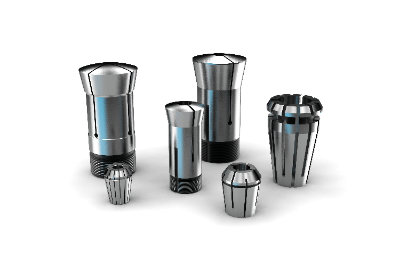What Is a Collet Chuck?

A collet chuck is a component used to secure a cutting tool or other tool during the cutting process of a material, mainly using a machine tool.
By pushing the Collet Chuck into a hole of the corresponding bore diameter, the collet incorporated in the chuck part closes and secures the object. The Collet Chuck can be secured by simply pressing it vigorously against a cylindrical member fixed to the machine, and can be easily detached by applying an impact in the direction of pulling the two apart.
Collet Chuck is a component that simplifies the installation and removal of tools. It can accommodate tools of different sizes, thus increasing the versatility of the machine tool.
Uses of Collet Chucks
Collet Chucks are primarily used on machine tools such as lathes and milling machines. It is used to mount cutting tools and drill pits.
When metalworking on a lathe or milling machine, cutting tools must be mounted. The Collet Chuck allows the cutting tool to be held firmly in place for precise machining operations.
Drill bits are used for drilling materials such as wood and metal. By using Collet Chuck, drill bits can be attached to lathes and milling machines.
Collet Chucks may also be used to attach mandrels and pin vises. Mandrels are used on lathes and milling machines to process cylindrical materials. A pin vise is a tool for drilling fine holes.
Principle of Collet Chuck
Collet Chuck is a component that uses a clamping force to hold a tool in place. A typical Collet Chuck is composed of a cylinder (collet) and a threaded part.
The collet is the part into which the tool is inserted and has multiple grooves on the inside. The threaded part is a screw to tighten the collet. When the screw is tightened, the barrel contracts and the tool is inserted into the collet.
The cylinder of the Collet Chuck is divided into three parts by a slit in the radial direction, and the outside diameter of the threaded part is set slightly larger. When the Collet Chuck is pressed against the inner diameter of the cylinder, the chuck section elastically deforms inward to hold the target shaft.
Similar tools that hold a shaft include drill chucks and scroll chucks. While a drill chuck holds the shaft with the tips of its three jaws, a Collet Chuck holds the shaft with its entire surface as if it were wrapped around the shaft. This has the advantage that the shaft is less likely to be damaged and the cutting tool is less likely to be off-center after repeated use.
Types of Collet Chucks
There are the following types of Collet Chucks:
1. Nut Type Collet Chuck
A nut is attached to the cylinder that holds the tool, and the tool is secured by turning the nut. It is used for general machine tools.
2. Screw Collet Chuck
A screw is attached to a tubular part that holds a tool, and the tool is secured by turning the screw. The position of the tool can be fine-tuned according to the angle of rotation of the screw. It is often mounted directly on the rotor to prevent the tool from popping out during high-speed rotation.
3. One-Touch Collet Chuck
This Collet Chuck has a button attached to the cylinder that holds the tool, and the tool is secured by pressing the button. The tool can be easily installed, thus reducing the burden on the user.
How to Select a Collet Chuck
When selecting a Collet Chuck, consider the tool size and applicable model.
Collet Chucks are available for different size tools. You should select the appropriate size Collet Chuck for the size of the tool to be used. Compatibility with tools and Collet Chucks you already own is also important.
The products that can be used with different machine tools also vary. If you do not select a Collet Chuck that is compatible with the machine tool to be used, you will not be able to use it. Selection is made according to the specifications of the tool.
Based on the above, selection is made in consideration of cost. The price of Collet Chuck depends on the type and accuracy. It is advisable to select a collet chuck in the appropriate price range by considering whether the cost is appropriate for the required accuracy.